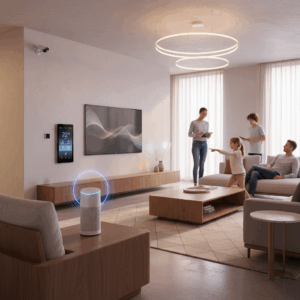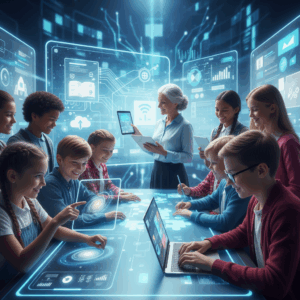Fundamentals and Technology of Augmented Reality
Augmented Reality (AR) integrates digital content into the real world, enhancing how we perceive our environment with interactive visual elements. This technology is transforming everyday experiences by merging virtual data seamlessly.
At its core, AR superimposes images, videos, or data onto the physical world, creating an enriched user view. These overlays provide contextual information that enhances tasks, entertainment, education, and navigation in real time.
As AR becomes more accessible, it shifts from a futuristic idea to a practical tool used across various industries, making digital interaction more intuitive and integrated with our surroundings.
How AR Overlays Digital Content on the Real World
AR works by detecting the user’s environment through cameras and sensors that map physical spaces. Digital content is then precisely placed over these real-world views to appear natural and interactive.
The technology often combines GPS, accelerometers, and computer vision to track locations and orientations, which enables accurate positioning of virtual objects in the environment.
These overlays adapt dynamically to the user’s perspective, maintaining alignment with real objects and allowing interaction with digital elements as if they were part of the physical space.
Through this blending, users engage with augmented visuals that offer additional information without losing sight of their actual surroundings, enhancing awareness and utility.
Devices Enabling Augmented Reality Experiences
Smartphones and tablets are the most common AR platforms, using their cameras, processors, and sensors to deliver augmented experiences to millions of users globally.
Specialized devices like AR glasses and headsets provide hands-free interaction, allowing users to see digital content overlaid directly in their field of vision with greater immersion and convenience.
These devices range from consumer-grade smart glasses to advanced mixed reality headsets used in professional environments, each offering distinct features for varied AR applications.
As technology advances, AR hardware becomes more lightweight, powerful, and affordable, expanding its presence in daily life and industry sectors alike.
Entertainment and Shopping Applications of AR
Augmented Reality (AR) revolutionizes entertainment and retail by merging digital elements with the real world, creating immersive and interactive experiences. This blending boosts engagement in gaming and shopping alike.
Users no longer passively view content; they actively interact with it, enhancing enjoyment and convenience. From games to online shopping apps, AR offers realistic previews and social features that enrich user experiences.
These practical applications of AR are transforming how consumers explore products and connect with others, making technology an integral part of daily entertainment and commerce.
Immersive Gaming Experiences with AR
AR gaming creates interactive worlds blending digital characters and objects with real environments, offering unique immersion beyond traditional screens. Players physically engage with their surroundings.
Popular games like Pokémon Go demonstrate how AR transforms ordinary locations into exciting play spaces, encouraging exploration and social interaction through shared experiences in real time.
The dynamic integration of virtual elements encourages creativity, strategy, and physical activity, making AR games highly engaging and socially connected platforms for entertainment.
As AR technology evolves, gaming experiences become more personalized, context-aware, and realistic, opening new dimensions for interactive storytelling and player involvement.
Enhancing Online Shopping through Visualization
AR enhances online shopping by enabling users to visualize products like furniture or clothing in their own space before purchase, reducing uncertainty and improving satisfaction.
Customers can try on virtual clothes, see how makeup looks on their skin, or arrange virtual furniture in their rooms using smartphone cameras or AR glasses, making shopping more interactive and confident.
This ability to preview products in real life contexts minimizes returns and increases buyer trust by providing clear, accurate representations directly on users’ devices.
Retailers incorporating AR tools often see higher engagement and conversion rates, showing how visualization technologies boost e-commerce success and customer experience.
AR in Social Interactions and Video Conferencing
AR enriches social interactions by adding filters, effects, and digital avatars to video calls, making communication more expressive and fun across distances.
Users share virtual environments, annotate shared spaces, or add playful enhancements in real time, which makes remote collaboration and socializing feel more personal and engaging.
These features break the monotony of standard video conferencing, encouraging creativity and emotional connection among participants despite physical separation.
Future of AR in Communication
As AR glasses improve, social and professional interactions will become more seamless, blending digital content naturally into our physical world for richer, immersive communication.
Educational and Navigation Uses of AR
Augmented Reality (AR) revolutionizes education by transforming static content into interactive 3D models. This enhances comprehension and engagement for learners of all ages.
In navigation, AR provides real-time guidance by overlaying directions and points of interest directly onto the user’s view, simplifying travel through unfamiliar spaces.
These applications demonstrate AR’s ability to merge digital information with physical surroundings, boosting efficiency and learning experiences.
Transforming Learning with Interactive 3D Models
AR enables students to explore complex subjects through 3D visualizations, such as anatomy, chemistry, or historical artifacts, making abstract ideas tangible and understandable.
By interacting with these models, learners gain deeper insight and retain information better compared to traditional textbooks or lectures.
Educational institutions adopt AR tools to create engaging lessons that stimulate curiosity and foster hands-on learning.
This technology supports diverse learning styles, helping students grasp challenging concepts via immersive and interactive means.
Real-Time Navigation and Location Assistance
AR enhances navigation by overlaying directional arrows and location details on live camera feeds, helping users find their way effortlessly indoors or outdoors.
Features like identifying stores, restrooms, or transit stops in malls and airports improve convenience and reduce stress during travel.
Combined with GPS and mapping data, AR provides context-aware assistance, adjusting guidance based on user location and surroundings in real time.
Travel and Maintenance Benefits of AR
Augmented Reality (AR) offers practical advantages for travelers and maintenance professionals by providing real-time information and interactive guidance. This enhances convenience and efficiency in everyday tasks.
In travel, AR delivers instant translations and historical data, while in maintenance, it guides users through complex repairs or assembly with clear, step-by-step visual instructions, saving time and reducing errors.
These applications demonstrate how AR bridges digital knowledge with physical interactions, making challenging activities more accessible and intuitive.
Instant Translation and Historical Insights for Travelers
Travelers benefit from AR apps that instantly translate foreign texts on signs, menus, or documents simply by pointing their devices, breaking language barriers on the go.
Additionally, AR can overlay historical facts and stories over landmarks, enriching visits with contextual information that transforms sightseeing into an educational experience.
This technology allows users to explore new places more confidently and engagingly, connecting digital knowledge with their physical environment in real time.
Step-by-Step Guidance in Repair and Assembly Tasks
AR offers interactive, visual instructions that overlay directly on objects, guiding users through repair or assembly tasks without needing to consult manuals extensively.
This approach reduces errors and frustration by illustrating precisely where and how to perform each step, making complex jobs manageable even for non-experts.
By enhancing clarity and hands-free accessibility, AR tools improve productivity and safety, especially in technical fields requiring precision.






